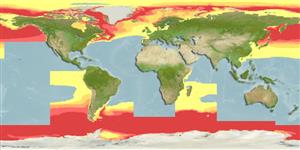Sagittoidea |
Phragmophora |
Eukrohniidae
Environment: milieu / climate zone / depth range / distribution range
Ecology
Pelagic-oceanic; depth range 0 - 3000 m (Ref. 1812). Temperate; -2°C - 17°C (Ref. 1705); 80°N - 76°S, 0°E - 0°E
Arctic, Atlantic, Indo-Pacific and the Antarctic. Common in Southeast Pacific.
Length at first maturity / Size / Weight / Age
Maturity: Lm ? range ? - ? cm Max length : 4.3 cm BL male/unsexed; (Ref. 2255)
Bipolar distribution with tropical submergence. Epipelagic in high latitudes and mesopelagic (Ref. 116362) or bathypelagic (Ref. 116365) in lower latitudes (Ref. 2255). Found at depths between 50 and 200 m during winter and spring and below 200 m during summer and autumn (Ref. 1812).
Life cycle and mating behavior
Maturity | Reproduction | Spawning | Eggs | Fecundity | Larvae
Members of the phylum Chaetognatha are hermaphroditic. Mating behavior: A preliminary visual signaling behavior for species recognition is observed to prevent predation. Life cycle: Eggs directly develop into miniature adults (hatchlings).
Hansson, H.G. 1998 NEAT (North East Atlantic Taxa): South Scandinavian marine "Aschelminth" (except Nematoda, which are treated separately and some other species poor phyla Check-List. Internet pdf Ed., http://www.tmbl.gu.se (Ref. 429)
IUCN Red List Status
(Ref. 130435: Version 2025-1)
CITES status (Ref. 108899)
Not Evaluated
Not Evaluated
Threat to humans
Human uses
| FishSource |
Tools
More information
Trophic EcologyFood items (preys)Diet compositionFood consumptionPredators Life cycleReproductionMaturityFecunditySpawningEggsEgg developmentLarvae PhysiologyOxygen consumption
Human RelatedStamps, coins, misc.
Internet sources
Estimates based on models
Preferred temperature
(Ref.
115969): 0.2 - 5.6, mean 1.6 (based on 2391 cells).
Fishing Vulnerability
Low vulnerability (10 of 100).
Price category
Unknown.
